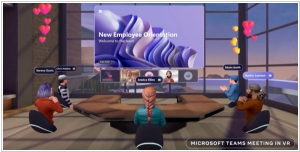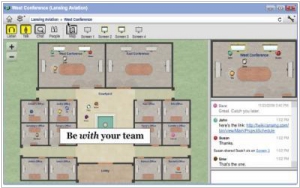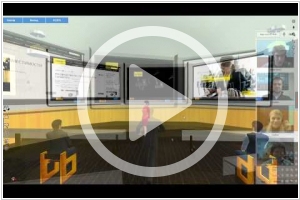Virtual Reality Worlds for Business
Updated: July 30, 2023
Virtual Worlds for Business are immersive and interactive digital environments that replicate real-world settings and scenarios. These virtual worlds enable businesses to conduct a wide range of activities, such as meetings, conferences, training sessions, product demonstrations, and team collaboration, in a virtual setting. Users can create customizable avatars and navigate through these virtual environments, interacting with other participants and digital objects. Virtual Worlds provide a unique and engaging platform for remote teams to collaborate, fostering creativity and team cohesion. They also offer a cost-effective alternative to physical events and travel, allowing businesses to reach a global audience without the need for physical presence. With the advancement of technology, Virtual Worlds are becoming increasingly realistic and intuitive, offering businesses endless possibilities for innovation, communication, and productivity enhancement.
See also: Top 10 Videoconferencing software
See also: Top 10 Videoconferencing software
2022. Meta partners with Microsoft to bring VR to Teams

Meta has recently announced a strategic partnership with Microsoft, aimed at incorporating Windows apps and integrating Microsoft Teams functionalities into Meta's metaverse hardware endeavors. This collaboration entails the integration of Microsoft Teams with Quest devices, enabling seamless communication and collaboration. Furthermore, Microsoft will provide a solution to stream Windows apps directly to Meta's headsets. The partnership also paves the way for the inclusion of custom 3D avatars in the metaverse experience. In terms of collaboration, Meta's VR space for teamwork, Horizon Workrooms, will be connected with Teams, allowing users to join Teams meetings directly from Workrooms. Additionally, Microsoft 365 will be accessible on Quest, enabling users to interact with content from productivity applications such as Word, Excel, PowerPoint, and Outlook. Notably, these are not full-fledged VR versions of the apps but rather Progressive Web Apps designed for the purpose.
2021. Microsoft Teams gets 3D animated avatars

Microsoft has unveiled 3D avatars for Teams meetings, offering an alternative for those who prefer not to appear on camera. These animated and personalized avatars are part of the "Mesh for Teams" initiative, which combines Microsoft's Mesh platform for shared experiences in virtual reality, augmented reality, and other realms with Teams and its integrated productivity tools. This feature transforms traditional meetings into a unique experience. Users can access Mesh for Teams using various devices, ranging from smartphones to VR headsets or HoloLens. Microsoft also allows businesses to create their own spaces, or metaverses, within Teams, enabling individuals to virtually interact and collaborate.
2020. HTC offers businesses virtual reality meetings
With the ongoing coronavirus lockdowns forcing millions of individuals to participate in online meetings from the comfort of their homes, HTC has introduced a solution that takes these meetings to the next level—virtual reality. HTC recently unveiled its Vive Sync platform, designed specifically for business meetings conducted in virtual reality, and it is now available for free until the end of 2020. Users familiar with VR applications will find the experience of using Vive Sync to be intuitive. To begin, users create their own Vive Sync avatar, starting with a selfie and then customizing it to their liking. The virtual meetings hosted on Vive Sync seamlessly integrate with popular business tools like OneDrive, enabling participants to share a variety of content such as PDFs, videos, and 3D models within the virtual meeting space. Currently, Vive Sync supports up to 30 participants per session. It is worth noting that all participants will require Vive headsets, which are priced between $549 and $1,000+. Employers, you now know what to do!
2013. Virtual 3D-worlds for business come back: Timvi
About 7 years ago the idea to bring virtual 3D worlds to business meetings emerged on the IT market. Some start-ups appeared and even Second Life opened the enterprise version of its virtual world. But then global economic crisis began and companies had no time to test the new toys. The 3D worlds for business were sent to the deadpool. Maybe their second coming will be more successful. Russian company Avrorus recently introduced their new platform Timvi - the virtual business center, where any company can build own 3D office or conference room of any size and use it for meetings with partners, customers or staff training. 3D office - is just an environment for online meetings. During the meeting, you can use the usual tools: video, voice, chat, screen sharing, online presentations. Why do you need this environment? ***
2010. Sococo Team Space - virtual office in four walls

How does a ordinary virtual office for the geographically-distributed teams look like? Probably something like Basecamp or Google Apps: user list with online status indication, chat, a page for shared files, calendar, tasks, forum. Looks minimalistic and efficient. But the lack of such online office is that the project participants don't have a team-feelings that comes when working in the same real office. Of course, there are already virtual worlds for business like Second Life, where you can create a realistic 3D-office and 3D-avatars. But for a small startup using such a 3D-world as an online office - is overkill. Sococo Team Space is something average between virtual reality and traditional online office. ***



